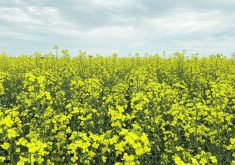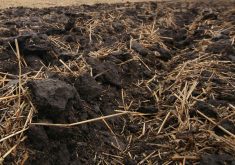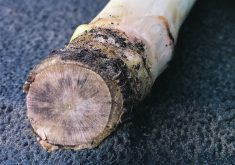As pathologists continue to check for verticillium stripe, researchers find a link between it and blackleg
Verticillium stripe, a disease of canola, is nearly everywhere in Manitoba and is now common in eastern Saskatchewan.
But it’s not in Alberta.
Plant pathologists in Alberta have searched for verticillium in post-harvest disease surveys since 2020. So far, they haven’t found it.
“In 2020, we found suspicious symptoms in about four fields, but the molecular testing of those… samples did not confirm the presence of verticillium,” said Michael Harding, crop health assurance lead with Alberta Agriculture.
“In 2021, we found suspicious symptoms in 11 fields, but again could not confirm the presence of verticillium…. Last year, we found suspicious symptoms in seven fields, but again could not confirm verticillium.”
Read Also

Huge Black Sea flax crop to provide stiff competition
Russia and Kazakhstan harvested huge flax crops and will be providing stiff competition in China and the EU.
That said, there have been anecdotal reports of the disease in the province.
“(It’s) not likely well-established here. At least it’s not common enough that it is showing up in our… monitoring efforts,” Harding said. “I believe most will not be surprised if it increases in prevalence over time, the same as it has done in Manitoba and now eastern Saskatchewan.”
Verticillium stripe is a new disease for canola growers in Western Canada. It was first discovered in 2014 near Winnipeg.
The fungus, Verticillium longisporum, infects canola and produces tiny, pepper-like sclerotia on or inside the stem of the plant. The sclerotia fall on the soil and into crop stubble after harvest. Then the small particles move with the wind and water to other locations. Farmers can also pick up the fungus on their boots and transport it to other fields.
The infection interferes with the uptake of water and nutrients. Symptoms include early ripening, plant stunting and leaf chlorosis, or yellowing of the leaf tissue. The symptoms usually appear late in the growing season.
Plant disease experts are still trying to understand the impact on canola yields. But results from Europe, on oilseed rape, suggest it can cause yields losses of 10 to 15 percent.
Researchers at the University of Manitoba have studied the disease in plots and greenhouses.
The research is in early stages, but verticillium stripe and blackleg in canola could be connected. Blackleg has been around much longer on the Prairies. Most canola growers are familiar with stem cankers and other symptoms of the disease.
U of M scientists have found that when blackleg is present, it may stimulate the growth of verticillium fungus.
“That blackleg interaction seems to increase the verticillium,” said Dilantha Fernando, a plant pathologist at the university. “And the other way around.”
So, if verticillium is present, it increases the severity of a blackleg infection in a canola plant.
“There seems to be that correlation.”
Fernando and his team have studied the relationship between the two fungi for only a short time — one round of experiments in a greenhouse.
They have found that the interaction between blackleg and verticillium depends on the resistance gene. In some cases, the presence of verticillium increases the blackleg infection.
In other cases, the verticillium doesn’t affect blackleg.
“Different lineages (types of verticillium) seem to have a different effect on blackleg, increase, no increase, or decrease,” Fernando said.
The U of M plant pathologists have also discovered that certain lines of canola, perhaps in the development pipeline or already in the market, have resistance to verticillium.
But the scientists don’t know the names or have specific information about the lines with resistance because the companies didn’t share those details.


















